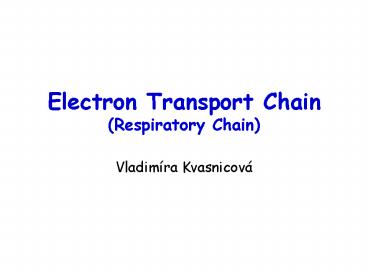Electron Transport Chain (Respiratory Chain) - PowerPoint PPT Presentation
1 / 26
Title:
Electron Transport Chain (Respiratory Chain)
Description:
... in a mitochondrion includes enzymes integrated in the inner mitochondrial membrane produces reducing equivalents (NADH+H+, FADH2) Respiratory chain ... – PowerPoint PPT presentation
Number of Views:553
Avg rating:3.0/5.0
Title: Electron Transport Chain (Respiratory Chain)
1
Electron Transport Chain(Respiratory Chain)
- Vladimíra Kvasnicová
2
Respiratory chain (RCH)
- is found in all cells
- is located in a mitochondrion
- includes enzymes integrated in the inner
mitochondrial membrane - produces reducing equivalents (NADHH, FADH2)
3
The figure is found at http//plaza.ufl.edu/tmulli
ns/BCH3023/cell20respiration.html (December 2006)
4
Respiratory chain (RCH)
- belongs among oxidative pathways
- can proceed under both aerobic and anaerobic
conditions - is a reversible pathway
- needs oxygen (O2) for its function
5
? reducing properties
Redox potential E
Gibbs energyG
? oxidizing properties
The figure is found at http//www.grossmont.net/cm
ilgrim/Bio220/Outline/ECB2FiguresTables_Ed2-Ed1/C
hapter14_13/REDOX_POTENTIALS_ElectronTransportChai
n_Fig14-21.htm (December 2006)
6
The figure is found at http//academic.brooklyn.cu
ny.edu/biology/bio4fv/page/mito_ox.htm (December
2006)
7
Enzymes of the RCH
- belong among oxidoreductases
- can transfer either H or electrons
- are called Complex I, II, III and IV
- transfer protons and electrons in the same
direction
8
proton H electron e-
Cytochrome c is drawn wrongly! It is found in
the intermembrane space, bound to the inner
mitochondrial membrane
The figure is adopted from the book Devlin, T.
M. (editor) Textbook of Biochemistry with
Clinical Correlations, 4th ed. Wiley-Liss, Inc.,
New York, 1997. ISBN 0-471-15451-2
9
The function of the RCH
- is to regenerate NAD from NADH
- is to regenerate NADP from NADPH
- is to regenerate FAD from FADH2
- is to finish oxidation of energy substrates and
conserve their energy in a form of ATP
10
In reactions of the RCH
- oxygen is reduced to H2O
- protons (H) are transfered into an intermembrane
space - ATP is produced by the Complex I
- all reduced coenzymes (NADHH and FADH2) are
reoxidized by the same mechanism
11
The figure is found at http//www.cellml.org/examp
les/images/metabolic_models/the_electron_transport
_chain.gif (December 2006)
12
Choose correct statement
- Complex I transfers H into an intermembrane
space - Complex II transfers H into an intermembrane
space - Coenzyme Q accepts e- from both Complex I and
Complex II - Complex IV transfers electrons to oxygen
13
proton H electron e-
Cytochrome c is drawn wrongly! It is found in
the intermembrane space, bound to the inner
mitochondrial membrane
The figure is adopted from the book Devlin, T.
M. (editor) Textbook of Biochemistry with
Clinical Correlations, 4th ed. Wiley-Liss, Inc.,
New York, 1997. ISBN 0-471-15451-2
14
Citrate cycle (CC) and the RCH are interconnected
- by CO2 (produced by CC, used by RCH)
- by NADH (produced by CC, used by RCH)
- an enzyme succinate dehydrogenase
- ATP (produced by RCH, used by CC)
15
Citrate cycle
succinate DH
The figure is found at http//www.cellml.org/examp
les/images/metabolic_models/the_electron_transport
_chain.gif (December 2006)
16
Adenosine triphosphate (ATP)
- can be produced only in a cooperation with RCH
- can be synthesized only under aerobic conditions
- is formed from ADP by addition of one phosphate
- is transported from a mitochondrion into a
cytoplasm by exchange with ADP
17
ATP-ADP translocase
The figure is adopted from the book Devlin, T.
M. (editor) Textbook of Biochemistry with
Clinical Correlations, 4th ed. Wiley-Liss, Inc.,
New York, 1997. ISBN 0-471-15451-2
18
When the term is used it always means ATP
synthesis
- phosphorylation
- oxidative phosphorylation
- aerobic phosphorylation
- substrate level phosphorylation
19
Oxidative phosphorylation
- needs proton gradient on the inner mitochondrial
membrane - is catalyzed by ATP synthase
- can be interrupted by uncoupling proteins (UCP)
- means ATP synthesis in any oxidative metabolic
pathway
20
The figure is adopted from the book Devlin, T.
M. (editor) Textbook of Biochemistry with
Clinical Correlations, 4th ed. Wiley-Liss, Inc.,
New York, 1997. ISBN 0-471-15451-2
21
inner mitochondrial membrane
ATP synthase
The figure is found at http//plaza.ufl.edu/tmulli
ns/BCH3023/cell20respiration.html (December 2006)
22
Uncoupling proteins(UCP) separate RCH from ATP
synthesis(the synthesis is interrupted)
energy from H gradient is released as a heat
The figure is found at http//departments.oxy.edu
/biology/Franck/Bio222/Lectures/March23_lecture_sh
uttles.htm (December 2006)
23
ATP (or GTP)can be formed by the reactions
- glucose-6-P ADP ? glucose ATP
- succinylCoA GDP ? succinate GTP
- GTP ADP ? GDP ATP
- ADP ADP ? ATP AMP
24
Oxidation of NADHH in the RCH produces more ATP
than oxidation of FADH2 because
- higher proton gradien is made by oxidation of
NADHH - NADHH transfers H to different Complex of the
RCH than FADH2 - more protons are transported to the intermembrane
space if NADHH is oxidized - more e- are transfered from NADHH to O2
25
FADH2
The figure is found at http//web.indstate.edu/thc
me/mwking/oxidative-phosphorylation.html
(December 2006)
26
Choose correct statement(s) about regulation of
RCH and ATP synthesis
- ? O2 decreases the pathways
- uncoupling proteins increase ATP synthesis
- ? ADP increses ATP synthesis
- ? NADHH/NAD increases the pathways

